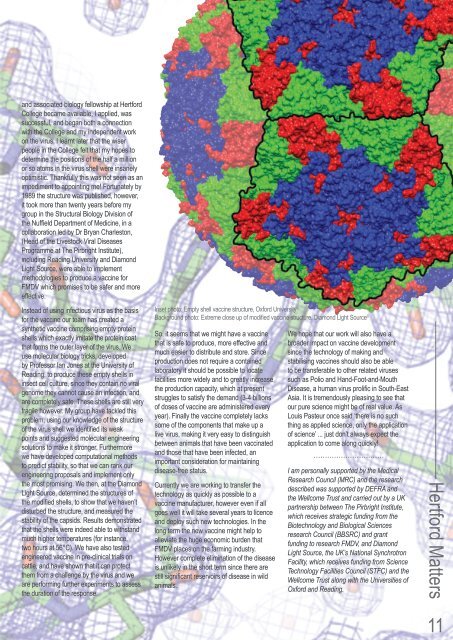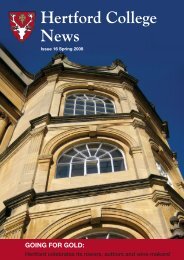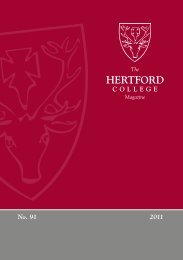Issue 24 - Hertford College - University of Oxford
Issue 24 - Hertford College - University of Oxford
Issue 24 - Hertford College - University of Oxford
- No tags were found...
You also want an ePaper? Increase the reach of your titles
YUMPU automatically turns print PDFs into web optimized ePapers that Google loves.
and associated biology fellowship at <strong>Hertford</strong><br />
<strong>College</strong> became available, I applied, was<br />
successful, and began both a connection<br />
with the <strong>College</strong> and my independent work<br />
on the virus. I learnt later that the wiser<br />
people in the <strong>College</strong> felt that my hopes to<br />
determine the positions <strong>of</strong> the half a million<br />
or so atoms in the virus shell were insanely<br />
optimistic. Thankfully this was not seen as an<br />
impediment to appointing me! Fortunately by<br />
1989 the structure was published, however,<br />
it took more than twenty years before my<br />
group in the Structural Biology Division <strong>of</strong><br />
the Nuffield Department <strong>of</strong> Medicine, in a<br />
collaboration led by Dr Bryan Charleston,<br />
(Head <strong>of</strong> the Livestock Viral Diseases<br />
Programme at The Pirbright Institute),<br />
including Reading <strong>University</strong> and Diamond<br />
Light Source, were able to implement<br />
methodologies to produce a vaccine for<br />
FMDV which promises to be safer and more<br />
effective.<br />
Instead <strong>of</strong> using infectious virus as the basis<br />
for the vaccine our team has created a<br />
synthetic vaccine comprising empty protein<br />
shells which exactly imitate the protein coat<br />
that forms the outer layer <strong>of</strong> the virus. We<br />
use molecular biology tricks, developed<br />
by Pr<strong>of</strong>essor Ian Jones at the <strong>University</strong> <strong>of</strong><br />
Reading, to produce these empty shells in<br />
insect cell culture, since they contain no viral<br />
genome they cannot cause an infection, and<br />
are completely safe. These shells are still very<br />
fragile however. My group have tackled this<br />
problem, using our knowledge <strong>of</strong> the structure<br />
<strong>of</strong> the virus shell we identified its weak<br />
points and suggested molecular engineering<br />
solutions to make it stronger. Furthermore<br />
we have developed computational methods<br />
to predict stability, so that we can rank our<br />
engineering proposals and implement only<br />
the most promising. We then, at the Diamond<br />
Light Source, determined the structures <strong>of</strong><br />
the modified shells, to show that we haven’t<br />
disturbed the structure, and measured the<br />
stability <strong>of</strong> the capsids. Results demonstrated<br />
that the shells were indeed able to withstand<br />
much higher temperatures (for instance,<br />
two hours at 56°C). We have also tested<br />
engineered vaccine in pre-clinical trials on<br />
cattle, and have shown that it can protect<br />
them from a challenge by the virus and we<br />
are performing further experiments to assess<br />
the duration <strong>of</strong> the response.<br />
Inset photo: Empty shell vaccine structure, <strong>Oxford</strong> <strong>University</strong> ©<br />
Background photo: Extreme close up <strong>of</strong> modified vaccine structure, Diamond Light Source ©<br />
So, it seems that we might have a vaccine<br />
that is safe to produce, more effective and<br />
much easier to distribute and store. Since<br />
production does not require a contained<br />
laboratory it should be possible to locate<br />
facilities more widely and to greatly increase<br />
the production capacity, which at present<br />
struggles to satisfy the demand (3-4 billions<br />
<strong>of</strong> doses <strong>of</strong> vaccine are administered every<br />
year). Finally the vaccine completely lacks<br />
some <strong>of</strong> the components that make up a<br />
live virus, making it very easy to distinguish<br />
between animals that have been vaccinated<br />
and those that have been infected, an<br />
important consideration for maintaining<br />
disease-free status.<br />
Currently we are working to transfer the<br />
technology as quickly as possible to a<br />
vaccine manufacturer, however even if all<br />
goes well it will take several years to licence<br />
and deploy such new technologies. In the<br />
long term the new vaccine might help to<br />
alleviate the huge economic burden that<br />
FMDV places on the farming industry.<br />
However complete elimination <strong>of</strong> the disease<br />
is unlikely in the short term since there are<br />
still significant reservoirs <strong>of</strong> disease in wild<br />
animals.<br />
We hope that our work will also have a<br />
broader impact on vaccine development<br />
since the technology <strong>of</strong> making and<br />
stabilising vaccines should also be able<br />
to be transferable to other related viruses<br />
such as Polio and Hand-Foot-and-Mouth<br />
Disease, a human virus prolific in South-East<br />
Asia. It is tremendously pleasing to see that<br />
our pure science might be <strong>of</strong> real value. As<br />
Louis Pasteur once said ‘there is no such<br />
thing as applied science, only the application<br />
<strong>of</strong> science’ ... just don’t always expect the<br />
application to come along quickly!<br />
I am personally supported by the Medical<br />
Research Council (MRC) and the research<br />
described was supported by DEFRA and<br />
the Wellcome Trust and carried out by a UK<br />
partnership between The Pirbright Institute,<br />
which receives strategic funding from the<br />
Biotechnology and Biological Sciences<br />
research Council (BBSRC) and grant<br />
funding to research FMDV, and Diamond<br />
Light Source, the UK’s National Synchrotron<br />
Facility, which receives funding from Science<br />
Technology Facilities Council (STFC) and the<br />
Wellcome Trust along with the Universities <strong>of</strong><br />
<strong>Oxford</strong> and Reading.<br />
<strong>Hertford</strong> Matters<br />
11




